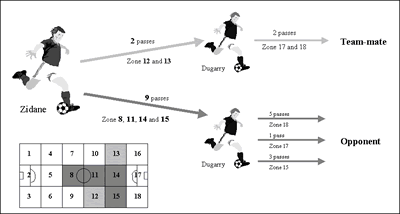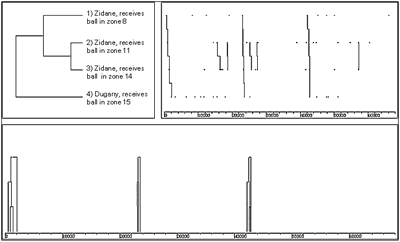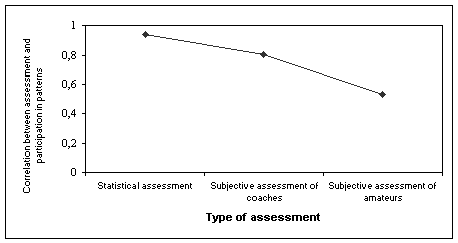
Detection of real-time interaction patterns in football
G.K. Jonsson
Human Behavior Laboratory, University of Iceland, Reykjavik, Iceland
The objective of the research presented in this paper was to search for particular types of repeated behavior patterns in football matches and to relate those patterns to elementary statistics and analysis. The pattern search was based on a method especially developed to detect such real-time behavior patterns using the computer software Theme [2,3]. Conventional football analysis has focused mostly on elementary statistics and field plots. Analysis of this type can provide information about the frequency of a team's and player's passes, the tendency of a player to take shots from one side rather than another and so on (see Figure 1).

This type of analysis, useful as it may be, does only to a very limited extent make it possible to study the relationship between the events described. This limitation is severe as a football match is not only a series of events but also highly structured. The fundamental elements of the game, the cooperation of (and competition between) a fixed number of actors in pursuit of a clearly defined objective, and the limits set on behavior, i.e. the usage of a clear set of rules and the well defined time and space frame, indicate the possibility of finding a causal relationship between events.

Figure 2. This pattern occurred three times during the first half of a match between Iceland and France, September 1998. The pattern displays how Zidane, cooperating with his teammates, (1) receives the ball in zone 8 (plays the ball towards the Icelandic goal), (2) receives the ball again in zone 11 (passes the ball forward), (3) receives it again in zone 14, (4) and finally he passes it on to Dugarry in zone 15.
Furthermore, teams as well as individual players have strategies that result in repeated patterns of behavior (see Figure 2) [1]. Some of these patterns can be observed whereas others require a sophisticated structural analysis to be detected. The current study focuses on the detection and analysis of complex intra- and inter-individual patterns. The Theme software detects such patterns by performing structural analysis of real-time behavior records that takes simultaneously into account information about both the order and the relative timing of behavioral events. Data from several World Cup and European club and national team games were collected using the Theme coding module, The Observer (Noldus Information Technology) and a match analysis system developed at the Research Institute for Sport and Exercise Sciences, Liverpool John Moores University, UK. The patterns detected were then related to elementary statistics, field plots and performance assessment.
The number, frequency and complexity of patterns detected in this pilot study indicates that the behavior of football players is more structured than the human eye can detect. This patterning was found to exist on different levels, with highly complex time structures that extended over considerable time spans, often in a cyclical fashion, as well as less complex patterns with a shorter time span. Winning teams were found to be more structured than loosing ones. Patterning of this kind was found to correlate highly with standard statistical assessment of individual performance and, notably, a higher correlation was found with performance assessment by professional coaches than by amateurs (see Figure 3).

Figure 3. Strong correlation was found between players' participation in patterns and standard statistical assessment of individual performance and a higher correlation was detected with performance assessment by professional coaches than by amateurs.
The results indicate that such pattern analysis can be used to study the structure of interaction in football and even to discover strategies and team structure.
Paper presented at Measuring Behavior 2000, 3rd International Conference on Methods and Techniques in Behavioral Research, 15-18 August 2000, Nijmegen, The Netherlands